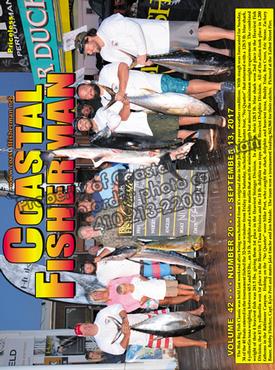


Article by Capt. Steve Katz
 Weather
Weather
With most of us focusing on the weather lately, this would be a good time to review weather resources for boating and fishing.
Most sport fishing captains and crews are looking for two types of weather resources, fishing weather and boating weather. Each of these areas requires different resources.
For fishing weather, at a minimum most crews are looking for sea surface temperature and many anglers also seek out data on chlorophyll, altimetry, salinity and ocean currents. Reviewing all of this data can help determine where the fish are and where the fish are going.
Boating weather helps ensure a safe, clear and calm ride to and from the fishing grounds. In addition to wind and waves, many captains seek out information on weather radar, tides currents, lightning, extended forecasts, high and low front movements, air pressure, humidity and many other elements of weather. While traveling to distant ports, many captains like to have an extended forecast of the area they will be traveling to. Specialized services offer a passage forecast that helps captains select the best weather window for a particular passage.
Ocean and bay weather patterns and forecasts can be very different from land forecasts in the same geographic area. Do not make the mistake by only relying on land based forecasts. There are many additional factors that make marine weather more complex than land weather, specifically water temperature, land mass temperature, dew points, currents, wind directions and tides can all affect the boating weather much differently than land weather.
Your available weather resources are largely dependent upon where you are boating. If you are boating and fishing in the back bays and near coastal waters around our area, then relying on NOAA weather radio broadcasts on your VHF or a Smartphone receiving internet marine weather data could meet all of your needs.
Land based boating weather offerings through the internet include popular smartphone apps such as Buoyweather, AccuWeather Marine Weather, PredictWind and of course websites like NOAA. There are also special services like Roffer's, Hilton’s and SSTOL that provide specialized fishing weather analysis.
Furuno and Raymarine both have an internet based weather application built into their newest chartplotters (requires a Wi-Fi internet connection). The Furuno weather service is free and available on the TZT and TZT2 line of multi-function displays.
If you are venturing more than about 10 miles from land, a satellite transmitted weather service is recommended. The most popular satellite weather service comes from SiriusXM. SiriusXM’s satellite weather is an interactive weather data service that provides graphical weather updates on the go. This weather information is sent to your boat by the same satellite technology that powers SiriusXM Radio. From radar and winds aloft to sea surface temperatures, wind shear and much more, SiriusXM offers the most accurate and timely meteorological and sea state data continuously delivered directly to your boat and is available throughout the continental United States and its adjacent waters. The subscription to this weather service begins at $13/month.
In order to receive this weather service, you will need a weather receiver and compatible chartplotter or a Windows based computer to display the weather data. Simrad, Lowrance and B&G all require a Navico WM-3 weather module. Furuno requires their BBWX3 weather module. Garmin requires a GXM52 or GXM53 weather module and Raymarine requires their SR150 weather module. Some older legacy weather modules may be compatible with SiriusXM weather, but check with you local marine electronics dealer to confirm features and functions. If you have a windows computer you can use a WxWorx receiver.
You may hear boaters talking about GRIB weather. Ever wonder what that is? GRidded Information in Binary or GRIB is an industry standard file used to store historical data and forecast weather data directly from numerical weather prediction programs. GRIB weather data is a cost effective and an objective weather tool.
Generally there is no human intervention or analysis of this GRIB data. It’s just pure raw data for the end user to analyze. You get to be the weather person, analyzing the data and making your own predictions. Once you obtain the GRIB file, you will need to use a viewer to see the graphical data. There are many viewers available for most computing platforms, (iOS, Android, Windows, etc). GRIB weather data files are available to download from NOAA and other weather providers.
As we all know, weather can change rapidly and unexpected weather can turn a good time on the water into a miserable experience, so please be sure to check the weather before you go boating and stay up-to-date during your trip.
Captain Steve Katz is the owner of Steve’s Marine Service and holds NMEA, AMEI and NMEA2000 certificates along with ABYC Master Technician certification and factory training from many manufacturers.